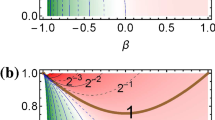Abstract
We study the fundamental problem of two gas species whose molecules collide as hard spheres in the presence of a flat boundary and with dependence on only one space dimension. More specifically the steady linear problem considered is the one arising when the second gas dominates as a flow moving towards the boundary with constant microscopic velocity (and hence zero temperature). Theboundary condition adopted consists of prescribing the outgoing velocity distribution of the firstgas at the boundary. It is discovered that the presence of the boundary under general assumptions on the outgoing distribution ensures the convergence of a series of path integrals resulting in a convenient representation for the distribution of the velocities of the molecules returning at the boundary.
Similar content being viewed by others
References
C. Bardos, R. E. Caflisch and B. Nicolaenko, The Milne and Kramers problems for the Boltzmann equation for a hard sphere gas, Comm. Pure Appl. Math. 39(3):323–352 (1986).
L. Boltzmann, (translated by Stephen G. Brush), Lectures on Gas Theory, Dover Publications, Inc. New York, 1964.
R. E. Caflisch, The Half-Space Problem for the Boltzmann Equation at Zero Temperature, Comm. Pure Appl. Math. 38: 529–547 (1985).
T. Carleman, Sur la théorie d'equation intégrodifférentielle de Boltzmann, Acta Math. 60:369–424 (1932).
T. Carleman, Problèmes Mathématiques dans la Théorie Cinétique des Gaz, Almqvist and Wiksel, 1957.
C. Cercignani, R. Illner and M. Pulvirenti, The Mathematical Theory of Dilute Gases, Applied Mathematical Sciences, 106 (1994) Springer-Verlag, New York.
M. Cessenat, Théorèmes de trace Lp pour les espaces de foinctions de la neutronique, C.R. Ac. Sci. Paris. Ser. I 299: 831–834 (1984).
F. Golse and F. Poupaud, Stationary solution of the linearized Boltzmann equation in half-space, Math. Methods Appl. Sci. 11: 483–502 (1989).
D. Hilbert, Grundzüge einer Allgemeinen Theorie der Linearen Integralgleichungen, (Teubner, Leipzig), Chap. 22.
T. Kato, Perturbation theory for linear operators, Die Grundlehren der mathematischen Wissenscheften, Band 132 (Springer-Verlag New York, Inc., New York 1966).
T.-P. Liu and S.-H. Yu, The Green's Function and large-Time Behavior of Solutions for One-Dimensional Boltzmann Equation, Comm. Pure Appl. Math. 57: 1543–1608 (2004).
Y. Sone, Kinetic theoretical studies of the half-space problem of evaporation and condensation, Transp. Theory Stat. Phys. 29:227–260 (2000).
Y. Sone, Kinetic Theory and Fluid Dynamics, Birkhauser (2002).
C. Villani, A review of mathematical topics in collisional kinetic theory. In (Handbook of Fluid Mechanics), S. Friedlander and D. Serre (eds.) (North-Holland, 2002).
Author information
Authors and Affiliations
Corresponding author
Rights and permissions
About this article
Cite this article
Sotirov, A. The Boundary Structure of Zero-Temperature Driven Hard Spheres. J Stat Phys 126, 95–116 (2007). https://doi.org/10.1007/s10955-006-9253-1
Received:
Accepted:
Published:
Issue Date:
DOI: https://doi.org/10.1007/s10955-006-9253-1




